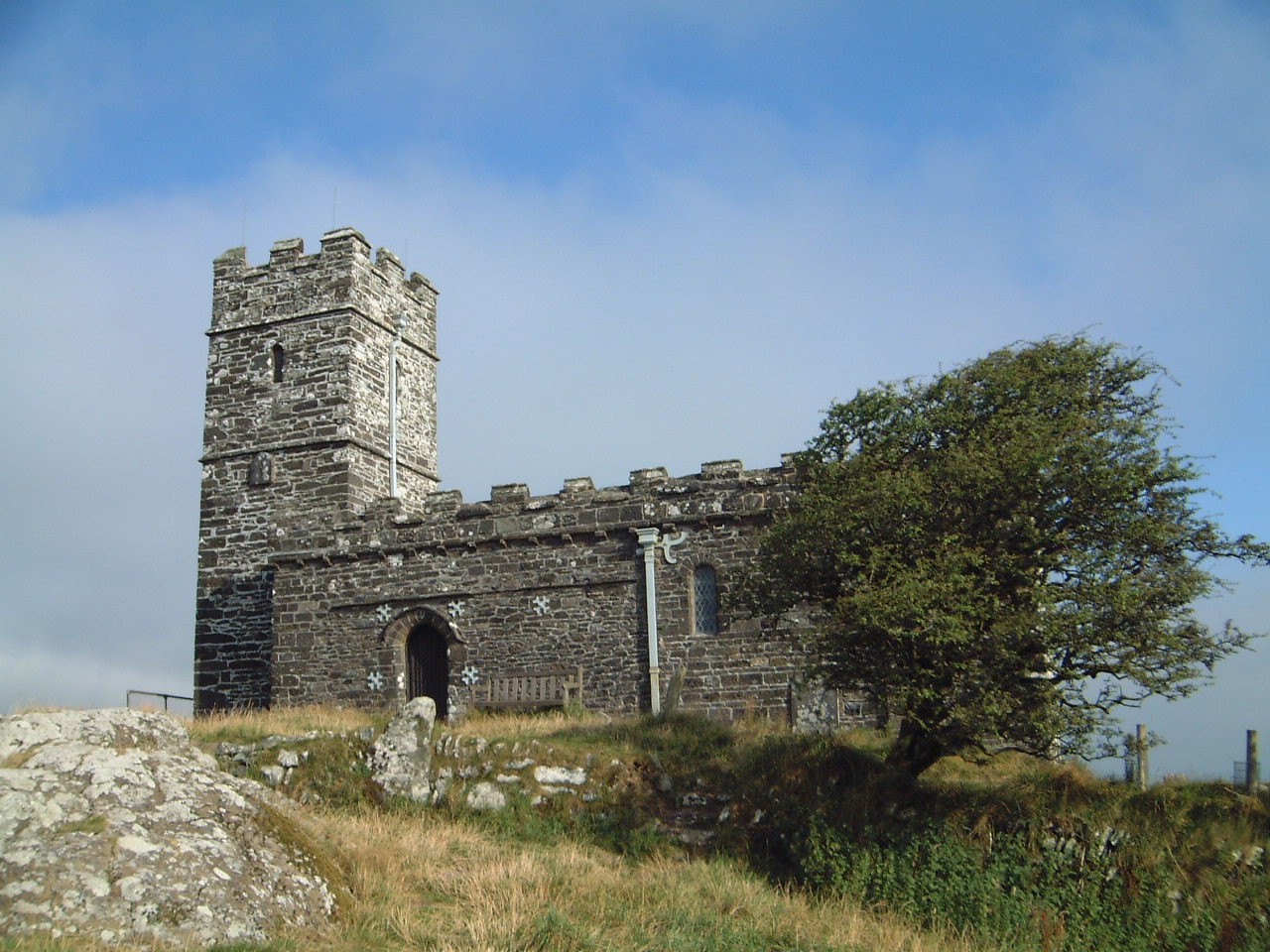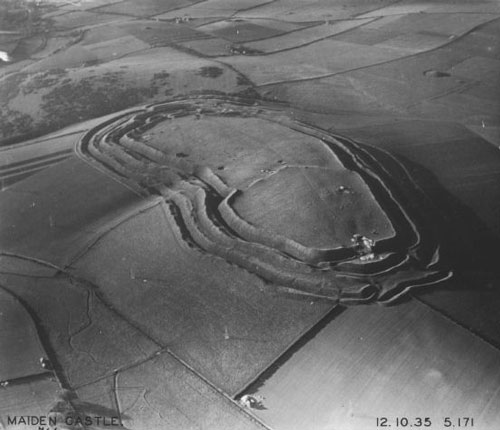|
Brent Tor
Brent Tor is a tor on the western edge of Dartmoor, approximately four miles (6.5 km) north of Tavistock, rising to 1100 ft (330m) above sea level. The Tor is surmounted by the Church of St Michael, the parish church of the village of Brentor, which lies below the Tor. Geology Brent Tor is an unusual example of early Carboniferous basaltic volcanic rocks, now weathered down. It is composed of volcanic breccia and pillow lava exuded beneath a former sea. History Around the Tor are Iron Age earthworks, the remnants of a Hill fort. Unusually, the fortifications are at the base of the Tor, rather than the summit as is more normal (compare with Brent Knoll in Somerset). No serious archaeological work has been carried out on the site. However, the northern ramparts in particular are well preserved, displaying a multi-vallate pattern characteristic of the Iron-A, or early -B, culture. There are three distinct consecutive ramparts in this sector, and traces of internal p ... [...More Info...] [...Related Items...] OR: [Wikipedia] [Google] [Baidu] |
Hill Fort
A hillfort is a type of earthwork used as a fortified refuge or defended settlement, located to exploit a rise in elevation for defensive advantage. They are typically European and of the Bronze Age or Iron Age. Some were used in the post- Roman period. The fortification usually follows the contours of a hill and consists of one or more lines of earthworks, with stockades or defensive walls, and external ditches. Hillforts developed in the Late Bronze and Early Iron Age, roughly the start of the first millennium BC, and were used in many Celtic areas of central and western Europe until the Roman conquest. Nomenclature The spellings "hill fort", "hill-fort" and "hillfort" are all used in the archaeological literature. The ''Monument Type Thesaurus'' published by the Forum on Information Standards in Heritage lists ''hillfort'' as the preferred term. They all refer to an elevated site with one or more ramparts made of earth, stone and/or wood, with an external dit ... [...More Info...] [...Related Items...] OR: [Wikipedia] [Google] [Baidu] |
Jamaica Inn (1983 TV Series)
''Jamaica Inn'' is a 1983 British television miniseries adapted from the 1936 novel ''Jamaica Inn'' by Daphne du Maurier. It is a gothic period piece of piracy, smuggling and murder set in northeastern Cornwall, England in the early 19th century. The series dramatizes the cultural trope of wreckers, clipper ship era pirates who employed various deceptions including mislocated lights, to lure ships to their doom on irregular rugged shorelines for subsequent plundering. It stars Jane Seymour, Patrick McGoohan and Trevor Eve and was directed by Lawrence Gordon Clark. Setting The production is set in Cornwall, England in the early 19th century, centered on a free house, 'Jamaica Inn' in Bodmin Moor near modern Bolventor. Plot When her seafaring husband dies in the destruction of his sailing ship by wreckers on the Cornish coast in the early 1800s, the shock causes Martha Yellan’s mental health to deteriorate. She plans to send her daughter Mary to stay with Martha’s sister Pat ... [...More Info...] [...Related Items...] OR: [Wikipedia] [Google] [Baidu] |
Medieval
In the history of Europe, the Middle Ages or medieval period lasted approximately from the late 5th to the late 15th centuries, similar to the post-classical period of global history. It began with the fall of the Western Roman Empire and transitioned into the Renaissance and the Age of Discovery. The Middle Ages is the middle period of the three traditional divisions of Western history: classical antiquity, the medieval period, and the modern period. The medieval period is itself subdivided into the Early, High, and Late Middle Ages. Population decline, counterurbanisation, the collapse of centralized authority, invasions, and mass migrations of tribes, which had begun in late antiquity, continued into the Early Middle Ages. The large-scale movements of the Migration Period, including various Germanic peoples, formed new kingdoms in what remained of the Western Roman Empire. In the 7th century, North Africa and the Middle East—most recently part of the Eastern Roman ... [...More Info...] [...Related Items...] OR: [Wikipedia] [Google] [Baidu] |
Spanish Armada
The Spanish Armada (a.k.a. the Enterprise of England, es, Grande y Felicísima Armada, links=no, lit=Great and Most Fortunate Navy) was a Spanish fleet that sailed from Lisbon in late May 1588, commanded by the Duke of Medina Sidonia, an aristocrat without previous naval experience appointed by Philip II of Spain. His orders were to sail up the English Channel, link up with the Duke of Parma in Flanders, and escort an invasion force that would land in England and overthrow Elizabeth I. Its purpose was to reinstate Catholicism in England, end support for the Dutch Republic, and prevent attacks by English and Dutch privateers against Spanish interests in the Americas. The Spanish were opposed by an English fleet based in Plymouth. Faster and more manoeuvrable than the larger Spanish galleons, they were able to attack the Armada as it sailed up the Channel. Several subordinates advised Medina Sidonia to anchor in The Solent and occupy the Isle of Wight, but he refused to ... [...More Info...] [...Related Items...] OR: [Wikipedia] [Google] [Baidu] |
Beacon
A beacon is an intentionally conspicuous device designed to attract attention to a specific location. A common example is the lighthouse, which draws attention to a fixed point that can be used to navigate around obstacles or into port. More modern examples include a variety of radio beacons that can be read on radio direction finders in all weather, and radar transponders that appear on radar displays. Beacons can also be combined with semaphoric or other indicators to provide important information, such as the status of an airport, by the colour and rotational pattern of its airport beacon, or of pending weather as indicated on a weather beacon mounted at the top of a tall building or similar site. When used in such fashion, beacons can be considered a form of optical telegraphy. For navigation Beacons help guide navigators to their destinations. Types of navigational beacons include radar reflectors, radio beacons, sonic and visual signals. Visual beacons range from smal ... [...More Info...] [...Related Items...] OR: [Wikipedia] [Google] [Baidu] |
Saint Michael
Michael (; he, מִיכָאֵל, lit=Who is like El od, translit=Mīḵāʾēl; el, Μιχαήλ, translit=Mikhaḗl; la, Michahel; ar, ميخائيل ، مِيكَالَ ، ميكائيل, translit=Mīkāʾīl, Mīkāl, Mīkhāʾīl), also called Saint Michael the Archangel, Saint Michael the Taxiarch in Orthodoxy and Archangel Michael is an archangel in Judaism, Christianity, Islam and the Baha'i faith. The earliest surviving mentions of his name are in 3rd- and 2nd-century BC Jewish works, often but not always apocalyptic, where he is the chief of the angels and archangels and responsible for the care of Israel. Christianity adopted nearly all the Jewish traditions concerning him, and he is mentioned explicitly in Revelation 12:7–12, where he does battle with Satan, and in the Epistle of Jude, where the author denounces heretics by contrasting them with Michael. Second Temple Jewish writings The earliest surviving mention of Michael is in a 3rd century BC Jew ... [...More Info...] [...Related Items...] OR: [Wikipedia] [Google] [Baidu] |
Somerset
( en, All The People of Somerset) , locator_map = , coordinates = , region = South West England , established_date = Ancient , established_by = , preceded_by = , origin = , lord_lieutenant_office =Lord Lieutenant of Somerset , lord_lieutenant_name = Mohammed Saddiq , high_sheriff_office =High Sheriff of Somerset , high_sheriff_name = Mrs Mary-Clare Rodwell (2020–21) , area_total_km2 = 4171 , area_total_rank = 7th , ethnicity = 98.5% White , county_council = , unitary_council = , government = , joint_committees = , admin_hq = Taunton , area_council_km2 = 3451 , area_council_rank = 10th , iso_code = GB-SOM , ons_code = 40 , gss_code = , nuts_code = UKK23 , districts_map = , districts_list = County council area: , MPs = * Rebecca Pow (C) * Wera Hobhouse ( LD) * Liam Fox (C) * David Warburton (C) * Marcus Fysh (C) * Ian Liddell-Grainger (C) * James Heappey (C) * Jacob Rees-Mogg (C) * John Penrose (C) , police = Avon and Somerset Polic ... [...More Info...] [...Related Items...] OR: [Wikipedia] [Google] [Baidu] |
Brent Knoll
Brent Knoll is a hill on the Somerset Levels, in Somerset, England. It is located roughly halfway between Weston-super-Mare and Bridgwater, from the Bristol Channel coast at Burnham-on-Sea. At the foot of the hill are two villages East Brent and Brent Knoll, which takes its name from the hill but was previously called South Brent. The hill's size and isolated position on the levels mean that it dominates the landscape and can be seen for many miles, and its prominence is emphasised to travellers because the Bristol to Taunton railway line, M5 motorway, A370 and A38 roads all pass within a mile or less from its base. Toponymy The word 'knoll' usually means a small hill or hill-top. The origin of the name Brent is unclear. The name may derive from the word "brant" meaning "steep" in Old English, although other suggestions have been put forward, such as from a word meaning ''burnt'' in Old English, suggesting that the settlement was at some time burnt by the Danes.Sylvanus U ... [...More Info...] [...Related Items...] OR: [Wikipedia] [Google] [Baidu] |
Iron Age
The Iron Age is the final epoch of the three-age division of the prehistory and protohistory of humanity. It was preceded by the Stone Age (Paleolithic, Mesolithic, Neolithic) and the Bronze Age (Chalcolithic). The concept has been mostly applied to Iron Age Europe and the Ancient Near East, but also, by analogy, to other parts of the Old World. The duration of the Iron Age varies depending on the region under consideration. It is defined by archaeological convention. The "Iron Age" begins locally when the production of iron or steel has advanced to the point where iron tools and weapons replace their bronze equivalents in common use. In the Ancient Near East, this transition took place in the wake of the Bronze Age collapse, in the 12th century BC. The technology soon spread throughout the Mediterranean Basin region and to South Asia ( Iron Age in India) between the 12th and 11th century BC. Its further spread to Central Asia, Eastern Europe, and Central Europe is somewhat ... [...More Info...] [...Related Items...] OR: [Wikipedia] [Google] [Baidu] |
Tor (rock Formation)
A tor, which is also known by geomorphologists as either a castle koppie or kopje, is a large, free-standing rock outcrop that rises abruptly from the surrounding smooth and gentle slopes of a rounded hill summit or ridge crest. In the South West of England, the term is commonly also used for the hills themselves – particularly the high points of Dartmoor in Devon and Bodmin Moor in Cornwall.Ehlen, J. (2004) ''Tor'' in Goudie, A., ed., pp. 1054-1056. ''Encyclopedia of Geomorphology.'' Routledge. London, England. Etymology Although English topographical names often have a Celtic etymology, the Oxford English Dictionary lists no cognates to the Old English word in either the Breton or Cornish languages (the Scottish Gaelic ''tòrr'' is thought to derive from the Old English word). It is therefore accepted that the English word ''Tor'' derives from the Old Welsh word ''tẁrr'' or ''twr'', meaning a cluster or heap. Formation Tors are landforms created by the erosio ... [...More Info...] [...Related Items...] OR: [Wikipedia] [Google] [Baidu] |







